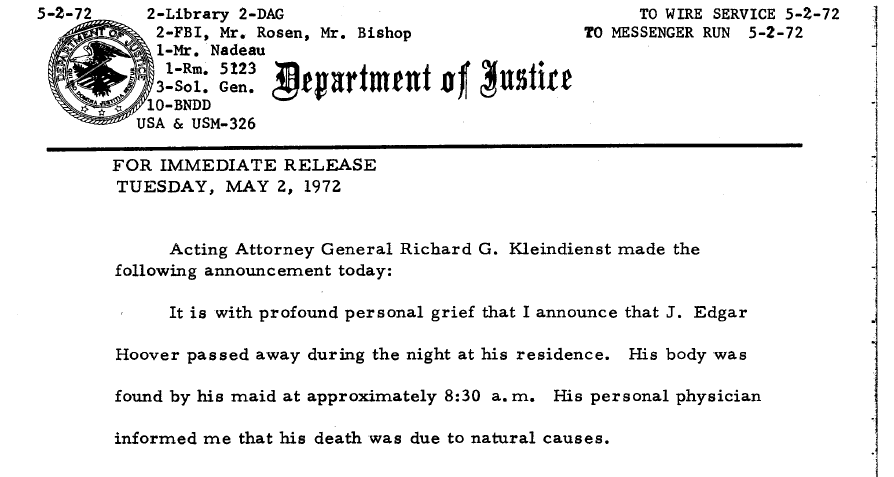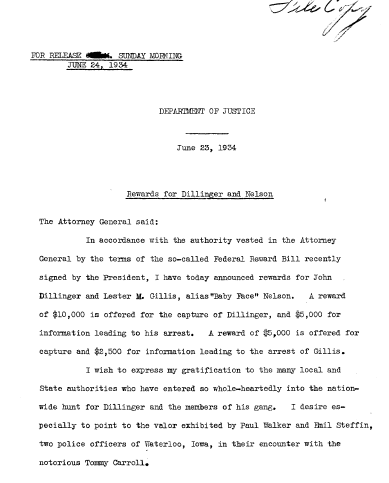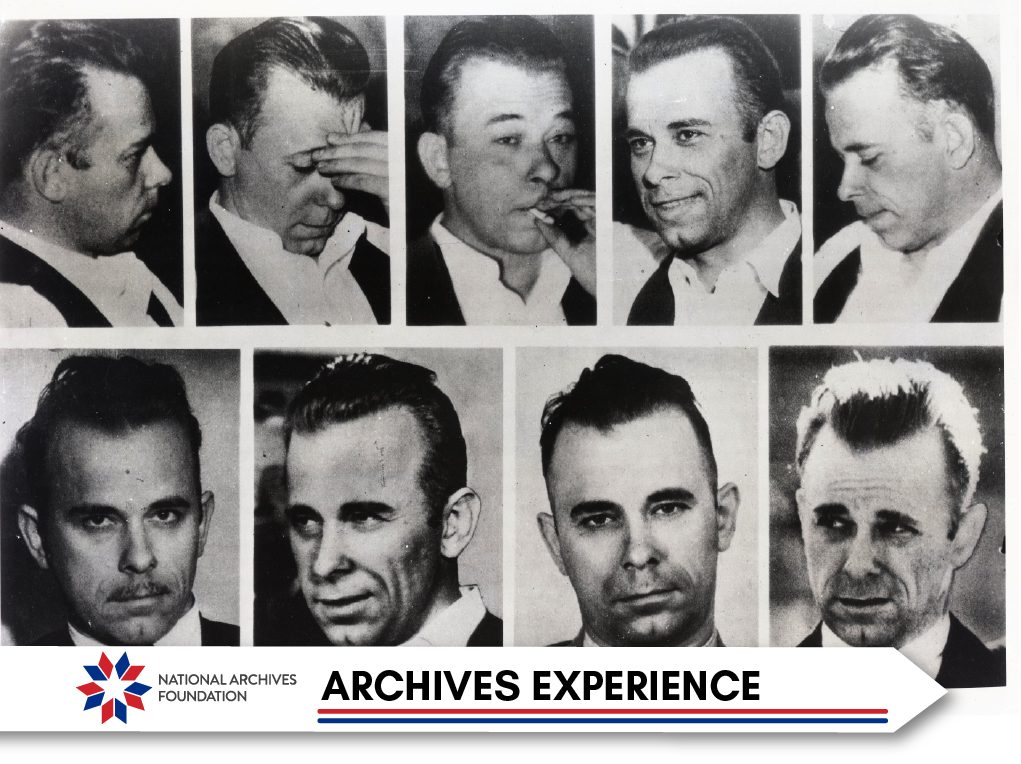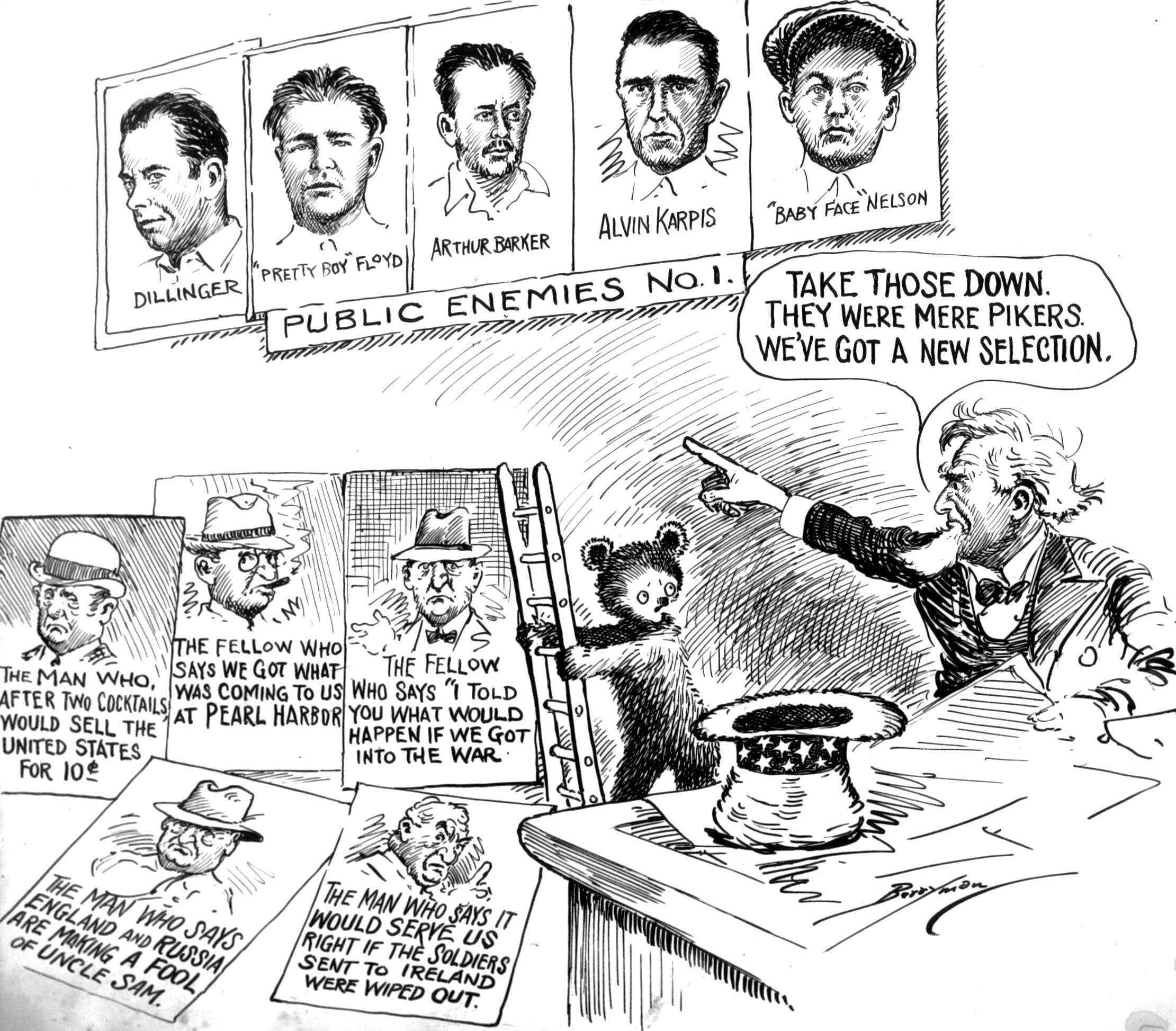Archives Experience Newsletter - January 23, 2024
Catch Them if You Can…
The Wild West doesn’t just refer to the untamed landscape or unexplored territory. It also means the lawlessness of the frontier, where bank robberies, train robberies, and other holdups and heists weren’t uncommon. In the 20th century, Prohibition and the Great Depression made a life of crime all the more attractive as liquor was made and sold on the black market and people were in need of extra cash. Some of these robbers became more notorious than others. We bet you’ll recognize a few names from the National Archives “Most Wanted” records…
In this issue
Jesse and Frank James
“But that dirty little coward
That shot Mr. Howard
Has laid poor Jesse in his grave.”

Last picture of Jesse James
National Archives Identifier: 336562115
It’s plausible that “The Ballad of Jesse James,” a song of uncertain origin that emerged shortly after Robert Ford shot Jesse James in his home in St. Joseph, Missouri, on April 3, 1882, was responsible for James becoming known as a champion of the poor over the rich—certainly the historical record doesn’t support that claim. Ford had ridden with Jesse and his brother Frank as a member of the James gang, who had specialized in robbing trains and banks. “Thomas Howard” was the alias Jesse was hiding out under in St. Joseph, but it didn’t protect him when Thomas T. Crittenden, the governor of Missouri, got fed up with the brothers’ antics and offered a $10,000 reward for the brothers’ capture, dead or alive.
During the Civil War, Frank joined up with William C. Quantrill and Jesse with “Bloody Bill” Anderson, both of whom commanded guerrilla groups in Kansas and Missouri. After the war, the two graduated to robbing banks and then to trains. Cole Younger, whom Frank had known during the war, joined the gang, and soon his brothers also joined up. The James brothers always insisted that government officials persecuted them because of their allegiance to the Southern cause.

Vice President John Nance Garner shows Senator Harry Truman Jesse James’ guns
National Archives Identifier: 348395281
On September 7, 1876, the James gang made the mistake of trying to hold up the First National Bank in Northfield, Minnesota. Unfortunately, the locals customarily went about armed, and a group of them greeted the James gang with a hail of gunfire. Three gang members were killed outright, and all three of the Younger brothers were wounded, one of them, Jim, very badly, and were captured. The James brothers escaped back to Missouri, where they laid low for a while to regroup.

Harry Truman in Texas holding Jesse James’ guns
National Archives Identifier: 345250267
By 1882, Jesse and Frank had gathered up a new gang and resumed robbing banks, trains, stores, and individuals when the governor intervened, and Robert Ford took matters into his own hands. Frank gave himself up shortly after his brother’s death. He was tried three times for various crimes and was acquitted each time, and then he returned home to live out his life quietly in Missouri. Edward Capehart O’Kelley shot and killed Robert Ford in Creede, Colorado, on June 8, 1892.
Bentley Bell was the first to record “The Ballad of Jesse James” in 1919, but Pete Seger, Bruce Springsteen, Van Morrison, and a host of other singers have since added it to their repertoire.
Bonnie and Clyde

Bonnie and Clyde newspaper
Bonnie Parker and Clyde Barrow, also known as the Barrow Gang, but best known simply by their first names as Bonnie and Clyde, were two of the most vicious criminals active during the Great Depression. They were only together for 21 months, but in that short time, they were credited with 13 murders, including those of several police officers, sheriffs, and deputies, and a long string of burglaries, robberies, kidnappings, and car thefts across Missouri, Texas, Oklahoma, New Mexico, and Louisiana.
When Bonnie met Clyde in January 1930, she was only 19 and he was 20, but he was already making a living by stealing cars and robbing stores. Shortly after he and Parker met, he was sent to Eastham Prison Farm, where he served 20 months for car theft. He emerged from prison a hardened criminal in February 1932, and he and Parker reunited and launched off on the crime spree that made them infamous.

Indictment against Raymond Hamilton, Clyde C. Barrow, Bonnie Parker, Henry Methvin, Joe Palmer, and Hilton Bybee
National Archives Identifier: 68887161

Palmer, and Hilton Bybee for theft of weapons from the Texas National Guard Armory
National Archives Identifier: 68887161
The Barrow Gang was a fluid group of outlaws who joined up and departed pretty much at will, including Clyde’s brother Buck and Buck’s wife Blanche. The press published sensationalized reports of their exploits, including some (bad) poetry written by Bonnie herself. The press initially suggested the Barrows were a “Robin Hood”-type gang that robbed from the rich and gave to the poor. But as their crimes grew increasingly vicious, the press began to turn on them, and the public did so as well.

Bonnie & Clyde
Source: The Reagan Library Educational Blog

Bonnie and Clyde next to their (stolen) car
The FBI got involved in tracking the Barrow Gang down when they started stealing cars and driving them across state lines. From December 1932 until January 1934, the bureau and the gang played cat and mouse, with the outlaws narrowly eluding capture several times and the bureau hotly pursuing them over country backroads. Finally, on May 23, 1934, a friend gave Bonnie and Clyde up, and police from Texas and Louisiana quite literally shot them to pieces as they drove on a highway between Gibsland and Sailes in Bienville Parish, Louisiana.

Court case of Jesse Warren v. Henderson Jordan–issue was ownership of the car which Clyde Barrow stole and was killed in
National Archives Identifier: 40240389
Did you know that the Reagan Library Education Team made a game out of the search for Bonnie and Clyde? This is especially fun for educators! Check it out here!

Indictment for Mary Pitts for harboring and concealing Clyde Barrow and Bonnie Parker
National Archives Identifier: 68884673
John Dillinger

John Dillinger wanted poster
Source: Prologue Magazine
Jailed for holding up a grocery store in Mooresville, Indiana, in 1924, John Dillinger spent nearly a decade in prison learning how to be a better criminal. When he was paroled in May 1933, he went on a crime spree that started with the robberies of five banks in Indiana and Ohio over a period of four months before he was arrested and jailed yet again.
In October, however, five ex-cons helped Dillinger escape from prison, and he and his new gang were off and running, robbing banks in Indiana and Wisconsin before fleeing to Arizona, where they were captured again. Dillinger was jailed in Crown Point, Indiana, but despite its reputation as being escape-proof, he managed to elude his captors one more time, heading to Chicago in a stolen car. This time, the FBI joined the hunt to bring him to justice.

John Dillinger wanted poster with fingerprints
Dillinger kept holding up banks with a revolving door of gang members. He eluded capture several times, sometimes by a hair’s breadth, but he was finally cornered when his companion of the moment, a madam named Ana Cumpanas who ran a brothel in Gary, Indiana, contacted the FBI and offered to set up his capture in exchange for a cash reward and for help with getting with her deportation case dealt with. She advised the agents that she and Dillinger would be going to see a movie in Gary. When she and Dillinger and a second woman exited the theater and the agents closed in on them, Dillinger quickly realized what was going on, pulled a gun from his pants, and raced into an alley, where the agents followed him and shot him down. John Dillinger was pronounced dead at the Alexian Brothers Hospital at 10:50 p.m. on July 22, 1934.

Warrant for the arrest of John Dillinger
Source: Prologue Magazine

DOJ announcement of John Dillinger’s death
Source: NARA’s Text Message blog
Baby Face Nelson
One of Dillinger’s more notable protégés was Lester M. Gillis, AKA George “Baby Face” Nelson, so-called because of his diminutive stature and delicate features. (Perhaps not surprisingly, Nelson hated his nickname.) Nelson got a very early start as a gangster—born in Chicago in 1908, he was running with a street gang, stealing cars, and bootlegging by the age of 14. Although Al Capone employed Nelson briefly in 1929, the Chicago mob boss let him go because he was too violent and uncontrollable even for him.
In and out of jail in his early twenties, Nelson also escaped several times and met up with other criminals like John Paul Chase and Homer Van Meter, with whom he went on to commit robberies and other crimes. In the early 1930s, Nelson and Chase rambled around California, Nevada, and Washington state, running liquor and committing mail fraud. During his criminal education, Nelson acquired several nasty habits like taking hostages and shooting police officers. Then in 1934, he and his partner headed for Chicago, where they joined up with John Dillinger.

DOJ announcement: $10,000 reward for Dillinger and $5,000
reward for Baby Face Nelson
Source: NARA’s Text Message blog
On June 30, 1934, Nelson, Homer Van Meter, and John Dillinger robbed the Merchants National Bank in South Bend, Indiana, shooting a police officer in the process. When two more cops tried to apprehend the gang at their hideout outside Chicago, Nelson shot and killed both of them.
Baby Face Nelson
–top right
Source: FBI Vault
After Dillinger was killed in July 1934, his gang fled Chicago, but Nelson and Chase reunited there in November, stole a car, and then went to Wisconsin. FBI agents spotted Nelson and Chase driving the car in Barrington, Illinois. When the agents pursued them, Nelson and Chase stopped and started firing automatic weapons at them.
One FBI agent was killed in the shootout, and a second died of his wounds the next day. Chase helped Nelson into one of the government cars and drove off with him. The next day, an anonymous tip directed the FBI agents to a cemetery in Niles Center, Illinois, where they found the body of Baby Face Nelson.












